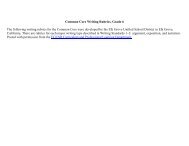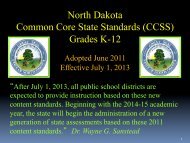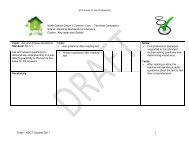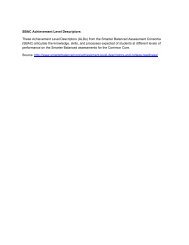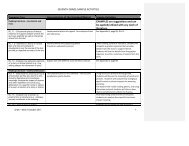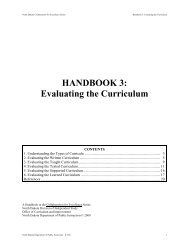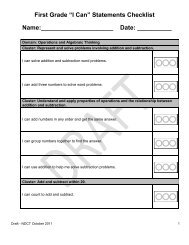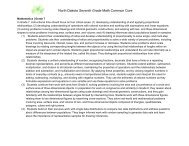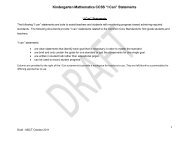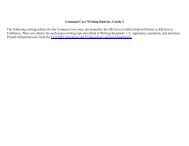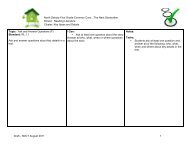A. ND Mathematics Content Standards, Grade 5 - ND Curriculum ...
A. ND Mathematics Content Standards, Grade 5 - ND Curriculum ...
A. ND Mathematics Content Standards, Grade 5 - ND Curriculum ...
You also want an ePaper? Increase the reach of your titles
YUMPU automatically turns print PDFs into web optimized ePapers that Google loves.
Parameter: A constant or a variable in a mathematical expression, which distinguishes various specific cases. For exampl e, in the equation y = mx + b, m and b are<br />
parameters which specify the particular straight line represented by the equation. (from <strong>Mathematics</strong> Dictionary, edited by Glenn James and Robert James, 1960,<br />
Princeton, New Jersey).<br />
Partition. Divide up into pieces.<br />
Percent rate of change. A rate of change expressed as a percent. Example: If a population grows from 50 to 55 in a year, it grows by 5/50 = 10% per y ear.<br />
Probability distribution. The set of possible values of a random variable w ith a probability assig ned to each.<br />
Properties of operations. See Table 3 in this Glossary.<br />
Properties of equality. See Table 4 in this Glossary.<br />
Properties of inequality. See Table 5 in this Glossary.<br />
Properties of operations. See Table 3 in this Glossary.<br />
Probability. A number betw een 0 and 1 used to quantify likelihood for processes that have uncertain outcomes (such as tossing a coin, selecting a person at random from<br />
a group of people, tossing a ball at a target, or testing for a medical condition).<br />
Probability model. A probability model is used to assign probabilities to outcomes of a chance process by examining the nature of the process. The set of all outcomes is<br />
called the sample space, and their probabilities sum to 1. See also: uniform probability model.<br />
Random variable. An assignment of a numerical value to each outcome in a sample space.<br />
Rational expression. A quotient of tw o polynomials w ith a non-zero denominator.<br />
Rational number. A number expressible in the form a/b or – a/b for some fraction a/b. The rational numbers include the integers.<br />
Rectilinear figure. A polygon all angles of w hich are right angles.<br />
Relative frequency. The ratio of the number of times that an event happens to the number of trials in which the event can happen or fail to happen. (Source: <strong>Mathematics</strong><br />
Dictionary, Glenn James and Robert James, 1960, Princeton, New Jersey)<br />
Repeating decimal. The decimal form of a rational number. See also: terminating decimal.<br />
Residual. The observed value minus the predicted value. It is the difference of the results obtained by observation, and by computation from a formula.<br />
Note: Italicized text indicates North Dakota additions to the glossary.<br />
North Dakota <strong>Mathematics</strong> <strong>Content</strong> <strong>Standards</strong><br />
Based on the Common Core State <strong>Standards</strong><br />
Glossary 19 June 2011



